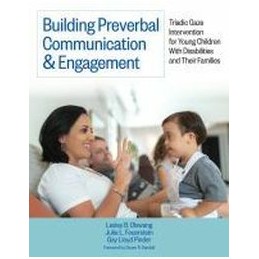During the first years of life, before a child’s first words, preverbal communication and engagement between children and their caregivers build an essential foundation for language and learning across domains. Many children with disabilities and their families struggle to connect early in life and need support developing early communication skills—and now there’s a comprehensive resource to help birth-to-three practitioners deliver that critical support to young children with disabilities and their families.
The product of more than three decades of research and clinical work, this accessible guidebook will help professionals harness the power of
Triadic Gaze Intervention (TGI), an evidence-based strategy that supports the development of early communication behaviors—gaze, gestures, and vocalizations—in young children with disabilities. Through
a straightforward protocol, practitioners will learn powerful techniques for helping caregivers engage young children during everyday routines and build their preverbal communication skills. In-depth practical guidance—enhanced with tip sheets, case examples, photos, and demonstration videos—make the protocol easy to learn and put into action with families and children.
A must for early interventionists, speech-language pathologists, occupational therapists, physical therapists, and other practitioners, this book is the key to helping young children with disabilities learn to successfully communicate, bond with their families, and engage with their world.
READERS WILL::- Learn about the six elements of the authors’ PoWRRS-Connect protocol for implementing TGI:: providing opportunity, waiting, recognizing, responding, shaping, and connecting
- Use the protocol to help children make progress toward IFSP goals related to communication and engagement
- Tailor the protocol for individual children with a range of disabilities and needs, including motor, sensory, or social impairments
- Embed opportunities for communication and engagement into each family’s authentic routines and activities
- Facilitate stronger collaborative partnerships with caregivers
- Discover how to monitor small measures of progress in engagement and communication through the lens of TGI
- Learn from four parents of children with complex communication needs, who share their success stories with TGI and describe their children’s current communication methods and abilities
PRACTICAL MATERIALS:: Easily implement the PoWRRS-Connect protocol in families’ daily routines with the downloads available online, including handouts for caregivers (available in English and Spanish), a communication checklist for assessment, and 19 brief demonstration videos.


 Dostawa
Dostawa
 Płatność
Płatność
 Zwroty
Zwroty
